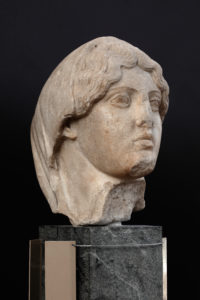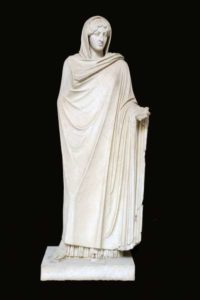Aphrodite Sosandra
Classical antiquity also suffered terrible epidemics.
The head of the Aphrodite ‘Sosandra’ (which in Greek means ‘saviour of men’), a marble Roman copy from the 2nd century A.D., is exhibited in the Archaeological Museum at the University of Pavia. It is a copy of the original bronze crafted by the Greek artist Calamides in the 5th century B.C., which unfortunately is no longer preserved. Bronze has always been precious and the statue was probably cast in order to make weapons. We know the features of the original thanks to a number of copies from the Roman age, including an intact example found in Baia (currently exhibited at the Archaeological Museum of Naples) and our head, which is of excellent workmanship and preserves traces of the colouring in the eyes. The original statue shone in the Propylaea, which served as the monumental entrance to the Acropolis of Athens during the so-called golden age of Pericles, a time to which a terrible plague put an end. The figure is completely wrapped in a cloak that also covers her head and, as Luciano di Samosata wrote, it is characterized by modesty, with a “dignified and light smile”.
Fortunately, epidemics end and the masterpieces survive immortal.


